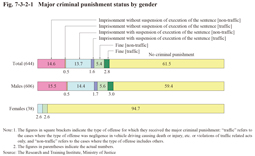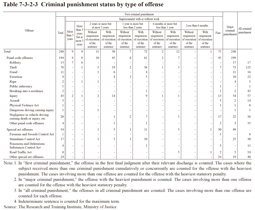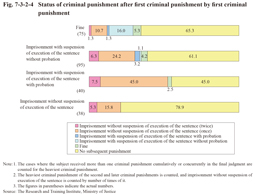1 Criminal punishment status
(1) General situation with criminal punishment
Fig. 7-3-2-1 shows the major criminal punishment the research subjects received before reaching age 25 and the types of offenses for which they received the criminal punishment by gender. Of 644 research subjects 97 (15.1%) received the major criminal punishment of imprisonment without suspension of execution of the sentence, 98 (15.2%) that of imprisonment with suspension of execution of the sentence, and 53 (8.2%) that of fine. Only two females received criminal punishment: one received the criminal punishment of imprisonment with suspension of execution of the sentence (Stimulants Control Act violations) and the other fine (theft), and no female received the criminal punishment of imprisonment without suspension of execution of the sentence.
Note that the percentage of the research subjects that received the criminal punishment of imprisonment without suspension of execution of the sentence was high at 15.1% when compared with the percentage imprisoned within five years of all the persons discharged from juvenile training schools in 2004 (year of the last discharge) of 9.2% (Table 7-2-5-4). This is considered to be due to the fact that the research subjects were limited to those aged 18 or 19 at the time of their relevant discharge and thus no junior/intermediate juveniles were included, with the follow-up period longer, being until age 25, and thus including five years after their becoming adults, than five years after their discharge.
Fig. 7-3-2-1 Major criminal punishment status by gender
Next, Fig. 7-3-2-2 shows the percent distribution of the research subjects by the number of times they received criminal punishment. Of those that received criminal punishment 37.5% received it two or more times. They repeatedly committed offenses within a short period of time at age 20-24, and thus had a strong tendency to repeat offenses.
Fig. 7-3-2-2 Percent distribution of research subjects by number of times they received criminal punishment
(2) First criminal punishment
Table 7-3-2-3 shows the number of research subjects by type of punishment/term of imprisonment in judgments of their first criminal punishment and the type of offense (if the judgment was based on multiple offenses the offense for which the heaviest statutory penalty was imposed was selected). Of 248 research subjects that received criminal punishment, 173 received their first criminal punishment of imprisonment with or without work, of which 38 imprisonment without suspension of execution of the sentence and 135 imprisonment with suspension of execution of the sentence (40 (29.6%) of them with probation), and 75 received their first criminal punishment of fine only. By the term of imprisonment, those sentenced to imprisonment for one year or more but less than two years accounted for the largest in number with the offense involved being theft and Stimulants Control Act violations, etc. In addition, nine were sentenced to imprisonment for over five years with the offense involved being robbery causing injury or injury causing death, etc.
Comparing the number of research subjects by type of offense in their first criminal punishment and in their major criminal punishment revealed that research subjects with the major criminal punishment involving theft, etc. was smaller in number than those with the first criminal punishment involving that offense, thus indicating some committed offenses with a heavier statutory penalty even after their first criminal punishment. In addition, across all criminal punishment theft was committed by the largest number of the research subjects (123), followed by injury, assault, or Physical Violence Act violations (total of 63), Road Traffic Act violations (54), breaking into a residence (43), negligence in vehicle driving causing death or injury, etc. (36), and Stimulants Control Act violations (30) (See Fig. 7-2-1-1-8 and Table 7-2-2-2).
Table 7-3-2-3 Criminal punishment status by type of offense
(3) More than one criminal punishment
Fig. 7-3-2-4 shows the status of persons with more than one criminal punishment by the first criminal punishment. The percentage of those that received more than one criminal punishment was 34.7% with those that received their first criminal punishment of fine, 38.9% with those imprisonment with suspension of execution of the sentence without probation, and 55.0% with those of imprisonment with suspension of execution of the sentence with probation, thus indicating that quite a few of those that were provided with the opportunity to reform/rehabilitate themselves within society then received criminal punishment again. Examining the percentage of those that received more than one criminal punishment of imprisonment without suspension of execution of the sentence revealed that 52.5% of them received their first criminal punishment of imprisonment with suspension of execution of the sentence with probation and 30.5% without probation, whereas 12.0% of them received their first criminal punishment of fine, thus indicating the percentage of those that received the first criminal punishment other than imprisonment without suspension of execution of the sentence and subsequently did not receive the criminal punishment of imprisonment without suspension of execution of the sentence to be high with those that received their first criminal punishment of fine.
Examining the type of offense committed by the 93 research subjects that received more than one criminal punishment revealed that 45 (48.4%) did not repeat the same type of offense, whereas 48 repeated the same type of offense, of which 29 (31.2%) repeated theft.
Fig. 7-3-2-4 Status of criminal punishment after first criminal punishment by first criminal punishment



